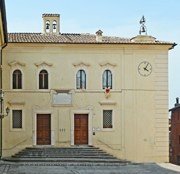


Pope Clement XII sent Monsignor Martino Innico Caracciolo to Narni in 1738 to reform the provision of care of the poor, the sick and abandoned children, and on his advice he authorised the establishment a new hospice in 1739. It was initially established in premises opposite the Chiesa di Sant' Agnese.
This foundation inherited the goods of a number of suppressed institutions, including the Ospedale dei Lebbrosi di San Bartolomeo and the Ospedale dei Pellegrini in the parish of San Giovanni Decollato. Pope Benedict XIV authorised its transfer to new premises in Piazza Galeotto Marzia in 1741.
In 1809-14, during the Napoleonic period, the hospice was temporarily merged with the Ospedale della Santissima Trinità and the Opera Pia Alberti e Nobili.
The complex passed to the Congregazione di Carità in 1864 and its activities were restricted to the care of orphans in 1883.
In 1933, the foundation was reconstituted as the independent Ospedale della Beata Lucia degli Esposti di Narni. It was renamed as the "Istituto Assistenza Infanzia Beata Lucia di Narni" in 1960 and continued its operations until 1980. [Subsequently re-opened?]
Church

The church, which is on the far side of the piazza, is dedicated to the Blessed Lucy of Narni. It was restored and reconsecrated in 2004. It is entered by the door on the right.
The inscription between this door and the door to the orphanage records the contributions made to the foundation of the complex by Clement XII, Benedict XIV and Monsignor Martino Innico Caracciolo
Vision of the Blessed Lucy (1750)


This altarpiece, which is signed by Etienne Parrocel, il Romano and dated by inscription, is on the high altar. The detail illustrated to the right shows a couple who are about to commit their children to the care of the hospice. The facade of the church is visible, but the Fabbrica Panni Di Lana (see below) to the right has been omitted to allow the side of the complex to be seen.
Ex Fabbrica Panni Di Lana

The building now belongs to the University of Perugia.
Art from the Complex
A number of works from suppressed religious institutions were moved here after 1866, before being transferred to the Pinacoteca.
St Bernardino of Siena (15th century)

The bust is sometimes attributed to to Lorenzi di Pietro, il Vecchietta. The inscription describes it as a "vero ritratto" (true portrait), suggesting that it was taken from a death mask.
Resurrection (ca. 1500)


This damaged but recently restored panel in the Pinacoteca was documented in the ownership of the Istituto Beata Lucia di Narni in 1872, but nothing is known of its original location. It seems to have been painted for a location in Narni: the cityscape to the left apparently represents the Rocca di Narni (at the extreme left), Porta Ternana (to the left of the spear) and presumably a gate that existed in the 16th century in front of the Arco Romano. The Institute still owns the panel, but it has allowed it to be displayed as part of the civic collection of Narni since 1969.
Marcantonio Aquili used a very similar composition for the central panel of a signed triptych (1511) for Santa Chiara, Rieti, which is now in the Museo Civico there. For this reason, the panel in Narni was also traditionally attributed to him. However, following its restoration, it is now attributed to his father, Antoniazzo Romano, whose cartoons Marcantonio habitually used. (An article on pp 8-9 in this issue of La Pagina describes the circumstances in which the new attribution was made).

